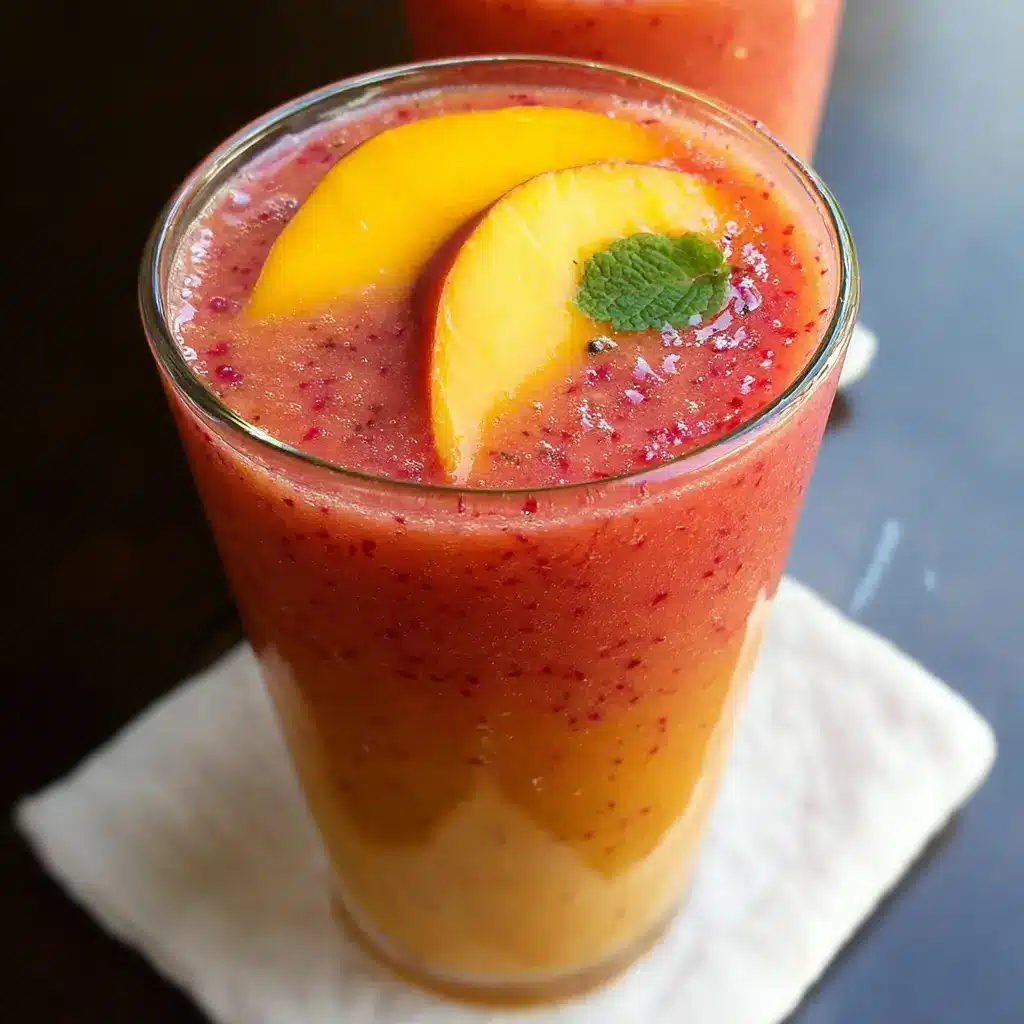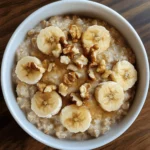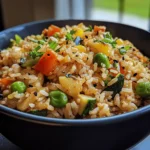There are some flavor combinations that just feel like pure sunshine in a glass, and for my family, this Mango Peach and Strawberry Smoothie is the undisputed champion. I first blended this vibrant concoction on a lazy Saturday morning when the kids were craving something sweet for breakfast, but I was determined to pack in some serious nutrition. The moment the blender whirred to a stop and I poured out the gorgeous, sunset-hued liquid, I knew I had a winner. The look on their faces said it all—a mixture of surprise and delight. It was sweet without being sugary, creamy without being heavy, and bursting with a complex fruitiness that made every sip an adventure. It has since become our go-to for everything from a quick, energizing breakfast on busy school days to a refreshing post-workout treat and even a healthy “dessert” on warm summer evenings. This isn’t just a recipe; it’s a mood-booster, a health-enhancer, and a delicious secret weapon for getting a massive dose of vitamins into my family without a single complaint.
Why This Is The Ultimate Fruit Smoothie Recipe
Before we dive into the specifics of how to create this masterpiece, let’s talk about why this particular recipe will become a staple in your kitchen. In a world saturated with smoothie recipes, this one truly stands out for its perfect balance, nutritional power, and sheer deliciousness.
- A Symphony of Flavors: This isn’t just a random mix of fruits. The mango provides a rich, tropical, and creamy base. The peach adds a delicate, floral sweetness and a soft, velvety texture. Finally, the strawberry cuts through with its bright, slightly tart notes, balancing the sweetness and adding a familiar, beloved berry flavor. Together, they create a multi-layered taste experience that is both refreshing and deeply satisfying.
- Nutritional Powerhouse: This smoothie is a vitamin bomb, in the best way possible. It’s loaded with Vitamin C from the strawberries and mangoes, which is essential for immune support and skin health. It’s also rich in Vitamin A from the mangoes and peaches, crucial for vision and cell growth. Plus, you’re getting a significant dose of dietary fiber, antioxidants, and essential minerals.
- Incredibly Easy and Fast: Despite its gourmet taste, this recipe is ridiculously simple. With just a handful of ingredients and a blender, you can have a café-quality smoothie ready in under 5 minutes. It’s the perfect solution for those hectic mornings when you need something nutritious on the go.
- Endlessly Adaptable: Think of this recipe as your perfect starting point. As you’ll see in our tips and variations sections, it’s incredibly easy to customize. You can boost the protein, add healthy fats, sneak in some greens, or switch up the liquid to suit your dietary needs and taste preferences, from vegan to dairy-free to protein-packed.
- Stunningly Beautiful: Let’s be honest—we eat with our eyes first! The color of this smoothie is a work of art. Its vibrant, swirling shades of orange, pink, and yellow are reminiscent of a beautiful sunrise. Serving this is guaranteed to brighten anyone’s day before they even take the first sip.
The Star Ingredients: A Closer Look
Understanding the role each ingredient plays not only enhances your appreciation for the smoothie but also empowers you to make smart substitutions and adjustments. Let’s break down our trio of superstar fruits.
Luscious Mango: The Tropical Creaminess
Mango is the heart of this smoothie, providing a naturally creamy texture and a wave of tropical sweetness.
- Flavor Profile: Sweet, slightly tart, with notes of pineapple and citrus. A good, ripe mango is key to a non-fibrous, smooth consistency.
- Health Benefits: Mangoes are an excellent source of Vitamin C, Vitamin A, and folate. They are packed with antioxidants, particularly mangiferin, which may help protect the body against cellular damage. Their fiber content also aids in digestion.
- Fresh vs. Frozen: Using frozen mango chunks is highly recommended for this recipe. It chills the smoothie perfectly without the need for ice, which can water down the flavor. It also ensures a thick, milkshake-like consistency. If you only have fresh mango, be sure it’s perfectly ripe (it should give slightly when pressed) and consider adding a half-cup of ice to achieve the right chill and thickness.
Sweet Peach: The Velvety Softness
Peaches lend a delicate, fragrant sweetness that complements the bold mango and bright strawberry. They contribute to the smoothie’s velvety mouthfeel.
- Flavor Profile: Subtly sweet, floral, and juicy. The flavor is less assertive than mango but provides an essential background note of summer.
- Health Benefits: Peaches are a good source of vitamins C and A, as well as potassium, which is important for maintaining healthy blood pressure. They also contain antioxidants like lutein and zeaxanthin, which support eye health.
- Fresh vs. Frozen: Like mangoes, frozen sliced peaches work brilliantly here. They eliminate the need to peel and pit the fruit, saving you time and ensuring the smoothie is thick and cold. If using fresh peaches during their peak summer season, simply wash, slice, and add them in. You may want to add a little ice if your other fruit isn’t frozen.
Bright Strawberry: The Tangy Zing
Strawberries are the high note in this fruit symphony, providing a burst of freshness and a beautiful pinkish hue.
- Flavor Profile: Bright, juicy, and a perfect balance of sweet and tart. They cut through the richness of the mango and prevent the smoothie from becoming overly sweet.
- Health Benefits: Strawberries are famous for their incredibly high Vitamin C content. A single serving can provide more than your daily requirement! They are also rich in manganese and packed with powerful antioxidants called polyphenols, which are linked to heart health and blood sugar control.
- Fresh vs. Frozen: Once again, frozen strawberries are a fantastic choice. They are picked at peak ripeness and flash-frozen, locking in their nutrients and flavor. Using frozen strawberries helps create that coveted thick, frosty texture. If you have an abundance of fresh, sweet strawberries, feel free to use them, but be prepared to add ice to compensate.
The Ultimate Mango Peach and Strawberry Smoothie Recipe
This recipe is designed for the perfect balance of flavor, texture, and nutrition. It’s a tried-and-true formula that delivers consistently delicious results every single time.
Ingredients
- Frozen Mango Chunks: 1 cup
- Frozen Sliced Peaches: 1 cup
- Frozen Strawberries: 1 cup
- Greek Yogurt: ½ cup (plain or vanilla for extra flavor and protein)
- Milk of Choice: 1 to 1 ½ cups (dairy milk, almond milk, oat milk, or coconut milk all work well)
- Optional Sweetener: 1-2 teaspoons of honey, maple syrup, or a pitted Medjool date (only if your fruit isn’t very sweet)
- Optional Nutrition Boost: 1 tablespoon of chia seeds or flax seeds for added fiber and omega-3s.
Instructions
Follow these simple steps for a perfectly blended smoothie. The order in which you add ingredients to the blender can make a difference in how smoothly it blends.
- Add Liquids First: Pour your milk of choice and the Greek yogurt into the base of your blender. Adding the liquids first helps the blades to move freely and prevents the frozen fruit from getting stuck.
- Add Softer Ingredients: If you’re adding any optional soft items like honey, dates, or seeds, add them now.
- Add Frozen Fruit: Add the frozen strawberries, frozen peaches, and frozen mango chunks on top of the liquid.
- Blend to Perfection: Secure the lid on your blender. Start blending on a low speed to break up the large pieces of fruit, then gradually increase the speed to high. Blend for 45-60 seconds, or until the mixture is completely smooth and creamy. If your blender has a tamper, use it to push the fruit down towards the blades.
- Check Consistency: If the smoothie is too thick to blend, stop the blender and add a splash more milk. If you prefer a thinner smoothie, add more milk until you reach your desired consistency.
- Taste and Serve: Give the smoothie a quick taste. If your fruit wasn’t particularly sweet, you can add a touch of honey or maple syrup and give it one last quick blend. Pour immediately into glasses and enjoy!
Nutrition Facts
- Servings: 2 large (approximately 16 oz each) or 3 small servings
- Calories per serving (for 2 large servings): Approximately 280-350 kcal, depending on the type of milk and sweetener used.
Disclaimer: The nutritional information provided is an estimate and can vary based on the specific ingredients and quantities used.
Preparation Time
- Total Time: 5 minutes
- Prep Time: 2 minutes
- Blend Time: 1-2 minutes
How to Serve Your Sunshine Smoothie
Presentation can elevate a simple smoothie into a special treat. Here are some of our favorite ways to serve this vibrant drink:
- The Classic Glass: Pour into a tall, clear glass to show off the beautiful, layered sunset colors. A reusable glass straw adds a nice touch.
- The Mason Jar: For a rustic, café-style feel, serve it in a large mason jar with a handle. This is also a great spill-proof option for kids.
- The Smoothie Bowl: Make the smoothie extra thick by reducing the milk to ¾ cup. Pour it into a wide, shallow bowl and get creative with toppings. This turns your drink into a satisfying and beautiful meal. Excellent topping ideas include:
- Fresh fruit slices (mango, peach, strawberries)
- A sprinkle of granola for crunch
- A dusting of shredded coconut
- A neat row of chia seeds or hemp hearts
- A drizzle of honey or melted nut butter
- Garnish for a Final Flourish: No matter how you serve it, a simple garnish makes it feel more special. Top your smoothie with:
- A fresh mint sprig
- A whole strawberry on the rim of the glass
- A thin slice of fresh peach
Additional Tips for Smoothie Perfection
After making hundreds of smoothies, I’ve learned a few tricks that guarantee a perfect result every single time. Here are my top five tips:
- Blending Order is Crucial: Always follow the “liquids first, then solids” rule. Placing the milk and yogurt at the bottom creates a vortex that pulls the heavier, frozen ingredients down into the blades. This prevents the blender from cavitating (when an air pocket forms around the blades) and ensures a smoother, faster blend without having to stop and scrape down the sides as often.
- Master Your Consistency: The thickness of your smoothie is a personal preference. The recipe provided gives a thick but drinkable consistency.
- For a Thicker, Spoonable Smoothie (like for a bowl): Use only ¾ to 1 cup of liquid and make sure all your fruit is frozen solid. You can also add half a frozen banana or a ¼ cup of rolled oats.
- For a Thinner, More Drinkable Smoothie: Simply add more of your chosen liquid, a tablespoon at a time, until you reach your desired flow. Using fresh fruit instead of frozen will also result in a thinner smoothie.
- Boost the Nutritional Profile: This smoothie is already healthy, but you can easily elevate it into a complete meal replacement or a powerful recovery drink.
- Add Healthy Fats: A tablespoon of almond butter or a quarter of an avocado will make the smoothie incredibly creamy and satisfying, adding healthy fats that keep you full for longer.
- Sneak in Greens: A large handful of fresh spinach is the perfect green to add. Its flavor is so mild that it will be completely masked by the powerful fruit flavors, but it will add a ton of iron, vitamin K, and other minerals. The color will change, but the taste won’t!
- Power up with Protein: Add a scoop of your favorite protein powder (vanilla or unflavored works best) to turn this into an excellent post-workout recovery shake. Alternatively, use extra Greek yogurt or add a few tablespoons of hemp hearts.
- Control the Sweetness Naturally: The best smoothies get their sweetness from ripe fruit, not from added sugars. Taste your fruit before you blend. If your mango is incredibly sweet and your strawberries are perfectly ripe, you likely won’t need any added sweetener. If your fruit is a bit on the tart side, a single pitted Medjool date is a fantastic, fiber-rich natural sweetener. Only resort to honey or maple syrup if absolutely necessary.
- Meal Prep for Ultimate Convenience: For the fastest possible smoothie experience, create “smoothie packs.” In a reusable freezer bag or container, portion out the 1 cup of mango, 1 cup of peaches, and 1 cup of strawberries. You can make 5-10 of these packs at a time and store them in the freezer. When you’re ready for a smoothie, just grab a pack, dump it in the blender with your liquid and yogurt, and blend. It shaves minutes off the prep time and makes healthy choices effortless.
Frequently Asked Questions (FAQ)
Here are answers to some of the most common questions about making this Mango Peach and Strawberry Smoothie.
1. Can I use all fresh fruit instead of frozen?
Absolutely! If it’s the middle of summer and you have an abundance of beautiful, ripe, fresh fruit, you should definitely use it. The flavor will be incredible. However, to achieve the classic thick, cold smoothie texture, you will need to add about 1 to 1.5 cups of ice to the blender along with the fruit. Without ice, your smoothie will be thin and room temperature. Using frozen fruit simply combines the “fruit” and “ice” steps into one.
2. Can I make this smoothie ahead of time?
While smoothies are always best enjoyed immediately after blending, you can make it ahead of time if needed. The best way is to pour the finished smoothie into an airtight container, like a mason jar with a tight-fitting lid, and fill it to the very top to minimize air exposure (which causes oxidation and separation). It will keep in the refrigerator for up to 24 hours. Before drinking, you’ll need to shake it vigorously or even give it a quick re-blend to restore its creamy texture, as some separation is natural.
3. Is this Mango Peach and Strawberry Smoothie actually healthy?
Yes, it is exceptionally healthy! It’s made from whole-food ingredients and is packed with essential nutrients. You’re getting a huge dose of Vitamin C for your immune system, Vitamin A for vision, dietary fiber for digestive health, and powerful antioxidants to fight inflammation. By using Greek yogurt, you’re adding protein and probiotics. By choosing unsweetened milk and avoiding added sugars, you’re keeping it naturally sweet and low in processed ingredients. It’s a fantastic way to meet your daily fruit intake goals.
4. What is the best kind of blender for making smoothies with frozen fruit?
A high-powered blender (like a Vitamix or Blendtec) will give you the smoothest, creamiest results with no fruit chunks, especially when using frozen ingredients and additions like seeds. However, you don’t need an expensive blender to make a great smoothie! Many standard, mid-range blenders (like those from Ninja or NutriBullet) are more than capable of handling frozen fruit. If your blender is less powerful, you can help it by cutting fruit into smaller pieces, adding a little extra liquid, or letting the frozen fruit sit out for 5 minutes to soften slightly before blending.
5. Can I make this smoothie dairy-free and vegan?
Easily! This recipe is incredibly simple to adapt for a dairy-free and vegan lifestyle. Simply make these two swaps:
- Milk: Use a plant-based milk like almond milk, oat milk (for extra creaminess), soy milk (for extra protein), or light coconut milk from a carton (for a tropical flavor).
- Yogurt: Substitute the Greek yogurt with a dairy-free yogurt alternative, such as one made from coconut, soy, or almonds. You can also skip the yogurt altogether and add half a frozen banana or a tablespoon of nut butter to achieve a similar creamy consistency.

Mango Peach and Strawberry Smoothie Recipe
Ingredients
- Frozen Mango Chunks: 1 cup
- Frozen Sliced Peaches: 1 cup
- Frozen Strawberries: 1 cup
- Greek Yogurt: ½ cup (plain or vanilla for extra flavor and protein)
- Milk of Choice: 1 to 1 ½ cups (dairy milk, almond milk, oat milk, or coconut milk all work well)
- Optional Sweetener: 1-2 teaspoons of honey, maple syrup, or a pitted Medjool date (only if your fruit isn’t very sweet)
- Optional Nutrition Boost: 1 tablespoon of chia seeds or flax seeds for added fiber and omega-3s.
Instructions
- Add Liquids First: Pour your milk of choice and the Greek yogurt into the base of your blender. Adding the liquids first helps the blades to move freely and prevents the frozen fruit from getting stuck.
- Add Softer Ingredients: If you’re adding any optional soft items like honey, dates, or seeds, add them now.
- Add Frozen Fruit: Add the frozen strawberries, frozen peaches, and frozen mango chunks on top of the liquid.
- Blend to Perfection: Secure the lid on your blender. Start blending on a low speed to break up the large pieces of fruit, then gradually increase the speed to high. Blend for 45-60 seconds, or until the mixture is completely smooth and creamy. If your blender has a tamper, use it to push the fruit down towards the blades.
- Check Consistency: If the smoothie is too thick to blend, stop the blender and add a splash more milk. If you prefer a thinner smoothie, add more milk until you reach your desired consistency.
- Taste and Serve: Give the smoothie a quick taste. If your fruit wasn’t particularly sweet, you can add a touch of honey or maple syrup and give it one last quick blend. Pour immediately into glasses and enjoy!
Nutrition
- Serving Size: One Normal Portion
- Calories: 280-350





